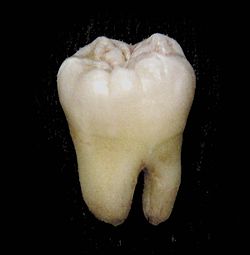Molar Teeth in Humans
- Molar teeth in humans have either four or five cusps.
- Adult humans have 12 molars, arranged in four groups of three at the back of the mouth.
- The third molar in each group is called a wisdom tooth.
- Wisdom teeth typically appear around the age of 20, but this can vary.
- Some individuals may have missing wisdom teeth.
Molar Evolution in Mammals
- In mammals, the crown of molars and premolars has complex shapes with cusps and valleys.
- Cusps contain dentine and enamel, while crenulations result from different enamel thickness.
- Mammalian cheek teeth likely evolved from single-cusped teeth in synapsids.
- Additional cusps may have arisen through budding or outgrowth from the crown.
- Therian mammals evolved from an ancestor with tribosphenic cheek teeth.
Morphology of Molars
- Upper molars have major cusps called cones, identified by prefixes like proto-, para-, meta-, hypo-, and ento-.
- Lower molars have cusps with the suffix -id, while minor cusps have the suffix -ule.
- A shelf-like ridge on the lower part of an upper molar is called a cingulum.
- A similar feature on a lower molar is called a cingulid.
- Minor cusps on the cingulid are referred to as cingular cuspules or conulids.
Tribosphenic Molars
- The tribosphenic molar is a key characteristic of therian mammals.
- The lower molar is divided into the trigonid (shearing end) and talonid (crushing heel).
- The trigonid has three large cusps: protoconid, anterior paraconid, and posterior metaconid.
- Upper molars have a mirrored structure with the protocone, anterior paracone, and posterior metacone.
- Tribosphenic molars likely developed independently in monotremes.
Different Types of Molar Morphologies
- Quadrate molars have a hypocone, an additional fourth cusp on the lingual side of the upper molar.
- Many mammals have additional smaller cusps called conules located between the larger cusps.
- Bunodont molars have low and rounded cusps, common among omnivores.
- Hypsodont dentition is characterised by high-crowned teeth with extended enamel.
- Brachydont dentition is characterised by low-crowned teeth, like human teeth.
- Zalambdodont molars have three cusps, one larger on the lingual side and two smaller on the labial side.
- Dilambdodont molars have a distinct ectoloph and are shaped like two lambdas or a W.
- Lophodont molars have enamel ridges called lophs that interconnect the cusps on the crowns.
- Selenodont molars have a major cusp elongated into a crescent-shaped ridge.
- Secodont teeth are adapted for slicing and chopping, commonly found in carnivorous mammals.
The molars or molar teeth are large, flat teeth at the back of the mouth. They are more developed in mammals. They are used primarily to grind food during chewing. The name molar derives from Latin, molaris dens, meaning "millstone tooth", from mola, millstone and dens, tooth. Molars show a great deal of diversity in size and shape across mammal groups. The third molar of humans is sometimes vestigial.
| Molar | |
|---|---|
 A lower wisdom tooth after extraction. | |
 Permanent teeth of right half of lower dental arch, seen from above: In this diagram, a healthy wisdom tooth (third, rearmost molar) is included | |
| Details | |
| Artery | Posterior superior alveolar artery |
| Identifiers | |
| Latin | dentes molares |
| MeSH | D008963 |
| TA98 | A05.1.03.007 |
| TA2 | 910 |
| FMA | 55638 |
| Anatomical terminology | |